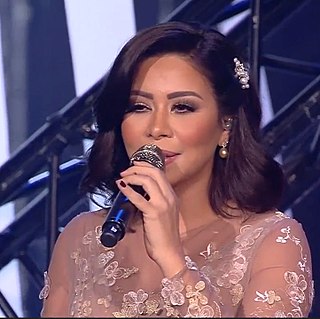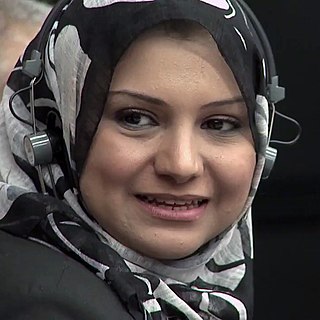Related Research Articles
Isaac Fanous was an Egyptian Copt iconographer, scholar and theologian, who single-handedly founded the most popular style of contemporary Coptic art today, commonly referred to as "Neo-Coptic".

Sherine Sayed Mohamed Abdel Wahab, known professionally as simply Sherine, is an Egyptian singer, actress and music judge who is dubbed "The Voice of Egypt". Sherine was formerly a judge on MBC's The Voice: Ahla Sawt.

Tahrir Square, also known as Martyr Square, is a public town square in downtown Cairo, Egypt. The square has been the location and focus for political demonstrations. The 2011 Egyptian revolution and the resignation of President Hosni Mubarak occurred at the Tahrir Square.
Tahia Mohammed Halim was an Egyptian painter. Tahia Halim was one of the pioneers of the Modern Expressive Movement in Egyptian Art in the 1960s, where she excelled in expressing the Egyptian character’s idiosyncrasies in her works. Many of her works concern the Nubian culture, the Nile, boats, and the popular and national subjects for which she has been granted several honorary awards in Egypt and abroad.
The Townhouse Gallery was established in 1998 as an independent, non-profit art space in Cairo, Egypt, with a goal of making contemporary arts accessible to all without compromising creative practice. The Townhouse supports artistic work in a wide range of media through exhibitions, residencies for artists and curators, educational initiatives and outreach programs. By establishing local and international relationships, as well as diversifying both the practitioners and audiences of contemporary art, the Townhouse aims to support and expand the knowledge, appreciation and practice of contemporary arts in Egypt and the region.

The 2011 Egyptian revolution, also known as the 25 January Revolution, began on 25 January 2011 and spread across Egypt. The date was set by various youth groups to coincide with the annual Egyptian "Police holiday" as a statement against increasing police brutality during the last few years of Hosni Mubarak's presidency. It consisted of demonstrations, marches, occupations of plazas, non-violent civil resistance, acts of civil disobedience and strikes. Millions of protesters from a range of socio-economic and religious backgrounds demanded the overthrow of Egyptian President Hosni Mubarak. Violent clashes between security forces and protesters resulted in at least 846 people killed and over 6,000 injured. Protesters retaliated by burning over 90 police stations across the country.

Asmaa Mahfouz is an Egyptian activist and one of the founders of the April 6 Youth Movement. She has been credited by journalist Mona Eltahawy and others with helping to spark a mass uprising through her video blog posted one week before the start of the 2011 Egyptian revolution. She is a prominent member of Egypt's Coalition of the Youth of the Revolution and one of the leaders of the Egyptian revolution.

Essam Abdel-Aziz Sharaf is an Egyptian academic who was the Prime Minister of Egypt from 3 March 2011 to 7 December 2011. He served as Minister of Transportation from 2004 to 2005.
Lamia Joreige is a Lebanese visual artist and filmmaker. She received a BFA from Rhode Island School of Design, Providence, Rhode Island. Since the late 1990s, her works have been widely displayed. She is a co founder and co director of the Beirut Art Center. In 2011, Sandra Dagher and Lamia Joreige organized “Museum as Hub: Beirut Art Center” at New York City's New Museum.
Ganzeer is the pseudonym used by an Egyptian artist who has gained mainstream fame in Egypt and internationally following the 2011 Egyptian Revolution. Prior to the revolution, Ganzeer's popularity was widespread yet limited to the spheres of art and design. Ganzeer's artwork has touched on the themes of civic responsibility and social justice and has been critical of the Supreme Council of the Armed Forces, or SCAF, which has ruled Egypt since the February 2011 resignation of former president Hosni Mubarak. Ganzeer means "chain" in Arabic. He is a regular contributor to the online magazine Rolling Bulb. Described by Bidoun Magazine as a "Contingency Artist," Ganzeer is quite accustomed to adopting completely new styles, techniques, and mediums to adapt to the topic he is tackling at any given time. The Huffington Post has placed him on a list of "25 Street Artists from Around the World Who Are Shaking Up Public Art," while Al-Monitor.com has placed him on a list of "50 People Shaping the Culture of the Middle East." He is one of the protagonists in a critically acclaimed documentary titled Art War by German director Marco Wilms. Ganzeer was also cited by German Arte as one of Egypt's highest-selling living artists today.
Tamer El Said is an Egyptian filmmaker. He wrote, produced and directed numerous films including Take Me (2004), an award-winning documentary about five friends who unwittingly became political prisoners in Morocco, and the short film On a Monday (2005) on an old married couple who rediscover their relationship. His first fiction feature In the Last Days of the City was shot in Cairo, Berlin, Baghdad and Beirut and premiered in 2016 at the Berlin International Film Festival. He is co-founder of several independent initiatives in Cairo, including Cimatheque Alternative Film Centre, Mosireen, and Zero Production.

Hend Kheera is an Egyptian street artist whose work features a mix of stencils and slogans. She is one of the leaders of Egypt's street-art boom since the 2011 uprising. Kheera has been an active participant in anti-sexual harassment campaign in Egypt in response to Mass sexual assault in Egypt
Contemporary art in Egypt refers to visual art, including installations, videos, paintings, or sculptures, developed in the Egyptian art scene. While the contemporary art scene is mainly concentrated in Cairo and Alexandria, it is developing fast with the emergence of spaces for artists, and support from the public or from abroad. Many Egyptian artists use the Egyptian contemporary art scene as a ramp toward the international art scenes.
Rape in Egypt is a criminal offense with penalties ranging from lifetime sentence to capital punishment. Marital rape is legal. By 2008, the U.N. quoted Egypt's Interior Ministry's figure that 20,000 rapes take place every year, although according to the activist Engy Ghozlan (ECWR), rapes are 10 times higher than the stats given by Interior Ministry, making it 200,000 per year. Mona Eltahawy has also noted the same figure (200,000), and added that this was before the revolution.

Women on Walls is a public art project in Egypt aimed at empowering women through the use of street art, by encouraging the portrayal of strong Egyptian female figures in street art and empowering female street artists themselves to participate in the political space of graffiti. Building on the popularity of street art as a form of political expression during the January 25 revolution, the aim of this project is to increase awareness of women's issues by introducing women into public space. This project was co-founded by Mia Gröndahl, a Swedish street art documentarian, and Angie Balata, an Egyptian artist, in December 2012 with funding from the Danish Center for Culture and Development, and was launched with a month-long event in the Spring of 2013 in Cairo, Luxor, Alexandria, and Mansoura that included painting sessions, workshops, and lectures on topics ranging from art to women's issues more generally. The project held its second campaign in February 2014.

The mass sexual assault of women in public has been documented in Egypt since 2005, when Egyptian security forces and their agents were accused of using it as a weapon against female protesters during a political demonstration in Tahrir Square, Cairo on 25 May. The behavior spread, and by 2012 sexual assault by crowds of young men was seen at protests and festivals in Egypt.
Huda Lutfi is a visual artist and cultural historian from Cairo, Egypt. Lutfi's works include paintings, collages, and installations that reflect a diverse style including pharaonic, Coptic, Western, Islamic, and contemporary international.
Nermine Hammam is an Egyptian artist who lives and works in Cairo and London.
Sabah Naim is a contemporary Egyptian multimedia artist. Her work focuses on documenting people and scenes in Cairo, Egypt, and incorporates street photography, painting, collage, embroidery, and video art.
Maha Maamoun, is an Egyptian award-winning visual artist and curator based in Cairo. She is a founding board member of the Contemporary Image Collective (CiC), an independent non-profit space for art and culture founded in Cairo in 2004. She also co-founded the independent publishing platform called Kayfa-ta in 2013. She was awarded the Jury Prize for her film Domestic Tourism II at Sharjah Biennal 9 (2009). Maamoun is a fellow of the Academy of the Arts of the World.
References
- ↑ Hack, Susan (February 2011). "Hidden Pleasures Of The Nile". Conde Nast Traveler. Gale A250562110.
- ↑ "Lara Baladi". The Future of a Promise. Retrieved December 4, 2011.
- ↑ Cotter, Holland (June 11, 1999). "Art in Review; 'Sampling'". New York Times. Retrieved December 4, 2011.
- 1 2 3 4 5 6 7 8 9 10 11 12 13 Schoene, Dorothea (2012). "Art in a Revolution: A Conversation with Lara Baladi". Afterimage. 39 (5): 19. Retrieved 17 February 2015.
- ↑ Feldman, Hannah; Zaatari, Akram (2007). "Mining War: Fragments from a Conversation Already Passed". Art Journal. 66 (Summer, 2007): 54. doi:10.1080/00043249.2007.10791254. JSTOR 20068532. S2CID 144640963.
- ↑ Issa, Rose; Krifa, Michket (2011). Arab Photography Now. Kehrer. p. 227.
- ↑ Beyond the Image: Dorothy Schoene, 29 January 2013 at ibraaz.org; retrieved 6 October 2017
- ↑ "Om El Dounia". Factum Arte. Retrieved December 4, 2011.
- ↑ Riding, Alan Riding (August 29, 2000). "Fresh Eyes Find Timeless Magic Within the Desert's Sand". New York Times. Retrieved December 4, 2011.
- ↑ "Lara Baladi". Barjeel Art Foundation. Retrieved 18 February 2015.
- 1 2 3 "Arabesque: new Middle Eastern art: continued". Modernedition.com. Retrieved 18 February 2015.
- ↑ "Sandouk el Dounia". Factum Arte. Retrieved December 4, 2011.
- ↑ Conway Morris, Roderick (June 13, 2011). "Show Highlights the Return of the Loom". New York Times. Retrieved December 4, 2011.
- ↑ Cotter, Holland (August 14, 2009). "Art in Review". New York Times. Retrieved December 4, 2011.
- ↑ "Al Fanous el Sehry". Factum Arte. Retrieved December 4, 2011.
- 1 2 3 Thompson, Seth (September 2008). "Cairo's Avant-garde". Afterimage. Ebsco 34685129.
- ↑ "Roba Vecchia". Factum Arte. Retrieved December 4, 2011.
- ↑ Thompson, Seth (July–August 2007). "Notions of ecology". Afterimage. Archived from the original on April 26, 2012. Retrieved December 4, 2011.
- 1 2 Keating, Michael (May–June 2009). ""Arabesque": art at the crossroads". Washington Report on Middle East Affairs. Gale A200066805.
- ↑ Mazria-Katz, Marisa (March 7, 2009). "Middle Eastern cultural diplomacy". Financial Times. Retrieved December 4, 2011.
- ↑ Moore, Rachel (12 November 2014). "Artist Lara Baladi to Speak about her Participation in 2011 Egyptian Uprisings". VTDigger.org. Retrieved 18 February 2015.
- ↑ "Coffee cups". Factum Arte. Retrieved December 4, 2011.
- ↑ Thompson, Seth (July 2010). "Beyond the frame". Afterimage. Archived from the original on March 25, 2012. Retrieved December 4, 2011.
- 1 2 "Lara Baladi Biography". Camilla Grimaldi Gallery. Archived from the original on 4 March 2016. Retrieved 17 February 2015.
- 1 2 "Lara Baladi". MIT Open Documentary Lab. Retrieved 17 February 2015.
- 1 2 3 Stuhr-Rommereim, Helen (20 July 2011). "Tahrir Cinema displays revolutionary power of archives". Egypt Independent. Retrieved 17 February 2015.
- 1 2 3 Baladi, Lara (16 September 2013). "When Seeing Is Belonging: The Photography of Tahrir Square". Creative Time Reports. Retrieved 17 February 2015.